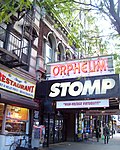Isaac T. Hopper House

The Isaac T. Hopper House is a Greek Revival townhouse at 110 Second Avenue between East 6th and 7th Streets in the East Village neighborhood of Manhattan, New York City. Located just south of the New Middle Collegiate Church, it was built in 1837 and 1838 as a rowhouse. The building was also known as the Ralph and Ann E. Van Wyck Mead House, after its first owner. 110 Second Avenue is the only remaining rowhouse out of a group of four at 106–112 Second Avenue that was used by the Meads' extended family, and was originally known as 108 Second Avenue. The building was added to the National Register of Historic Places in 1986, and was designated a New York City landmark in 2009. It is also located within the East Village/Lower East Side Historic District, which was created in October 2012.
Excerpt from the Wikipedia article Isaac T. Hopper House (License: CC BY-SA 3.0, Authors, Images).Isaac T. Hopper House
2nd Avenue, New York Manhattan
Geographical coordinates (GPS) Address Nearby Places Show on map
Geographical coordinates (GPS)
| Latitude | Longitude |
|---|---|
| N 40.7275 ° | E -73.988055555556 ° |
Address
2nd Avenue 108
10003 New York, Manhattan
New York, United States
Open on Google Maps






